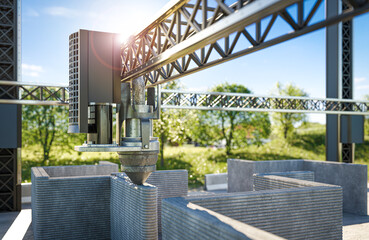Whether you’re building a convenience store or expanding your office, it’s important to work with contractors who are experts in their fields. Commercial General Contractors Oklahoma City know what it takes to keep construction projects on time and within budget.
They are familiar with all the necessary codes and permit regulations for any building project and ensure that the structure will be safe for years to come.
Building codes are a set of minimum standards that every construction project must meet. They exist to ensure that a building is safe and comfortable for its occupants, protect citizens from hazards, and promote innovation and quality. They’re also an important part of any local government’s economic development and competitiveness, encouraging business investment by providing a predictable, cost-effective baseline of building performance.
A commercial general contractor will need to be familiar with the regulations that apply to their specific jurisdiction. This includes knowing what types of work require a permit and how long the process will take. It’s also important to have a strong relationship with the team at the permitting office, which can help avoid delays that could impact your timeline.
The specific rules vary by jurisdiction, but it’s common for large projects to require a permit for some portion of the build. In addition, contractors will need to have the appropriate licenses. For example, New York state requires contractors to have a general building contracting license to perform any kind of work on residential and small commercial properties.
In many cases, the permit requirements will be the same from jurisdiction to jurisdiction, with minor differences for things like climate and historic or cultural preferences. This consistency benefits building professionals and consumers alike, as it provides a common-language script that architects, engineers, builders/contractors and inspectors can reference during the design process. It also drives the market for product innovation, ensuring that all building materials are held to a minimum standard.
Local governments enforce these codes to improve the safety of buildings and the safety of citizens, which is a good thing. However, some of these regulations are costly to builders, and they can delay anticipated project timelines. An experienced construction management team will have a deep understanding of the permit requirements that apply to their specific area, helping them avoid costly delays that can throw off your entire budget.
Risk Management
Risk management is a major part of any contractor’s job description. With tight time frames, multiple stakeholders up and down the value chain, and dangerous working conditions, construction projects are inherently risky. Unfortunately, it is nearly impossible to prevent or stop all risks from occurring on a project, but the best general contractors do everything in their power to minimize them.
A contractor’s risk management plan should include a list of the risks that could impact the success of a project and their severity. Then, the risk management team should determine a plan to manage those risks. Risks that pose a large impact and high probability can be avoided, while those with a small impact and low probability should be accepted. Then, the risks should be prioritized based on their level of urgency. The highest priority risks should be dealt with immediately, while those with a lower level of importance can be addressed later.
The most common risks faced by general contractors are financial, design, environmental, and project timeline impacts. Construction professionals can mitigate some of these risks by making changes to the scope of work, adjusting budgets, and adjusting schedules. They can also reduce the likelihood of these events occurring by implementing a risk assessment matrix that identifies and ranks different types of risks based on their impact and probability.
Getting the right people onboard for a project is another way to reduce a commercial general contractor’s risk. Many construction professionals struggle with an ongoing skilled labor shortage, and using a workforce qualification platform can help to ensure that only the most qualified people are hired for a job.
The best general contractors also have a strong safety program in place that is a core culture throughout the entire company. This includes ensuring that all employees are aware of and have the necessary training and equipment to complete their work safely, and providing training for new hires. Additionally, they often use insurance policies to protect themselves against losses related to professional negligence, property damage, and general liability claims. They also maintain a reserve of money to cover costs or delays that might occur on the project.
Safety
Construction jobs come with many risks, such as exposure to asbestos, noise, vibration, electricity, moving equipment, and falling materials. Commercial general contractors must implement safety systems to protect their crews from these risks and minimize injuries. Safety must be a top priority for all personnel, from the management team to the crew members who work on each project.
Contractors must create a culture of safety that permeates their entire company, with everyone involved in implementing safe operating procedures on each project. This begins with the CEO and owner of each business and moves down to the managers and supervisors who oversee the various job sites. A solid safety program includes a clear and concise set of rules that are followed by all workers. It also includes a training and assessment program for workers to ensure they have the proper skills to complete tasks safely.
In order to reduce construction site accidents and injuries, contractors should be sure that all employees have the proper personal protective gear (PPE) to work on each job site. PPE can include back braces, eye protection, steel-toed shoes, and gloves, depending on the type of construction work. Contractors should also ensure that they have sufficient staff to avoid working long shifts, as tired workers are more prone to accidents and injuries.
Lastly, contractors must train workers on the proper method for loading and unloading equipment and materials. This includes ensuring the equipment is secured to prevent it from rolling over, which can injure workers. Contractors should also host toolbox talks on a daily basis to relay important health and safety information to the workforce.
Communication
Communication is one of the most crucial aspects of any construction project. Unfortunately, it’s also a common source of frustration and conflict for many building professionals. Construction projects involve a lot of people and multiple departments, which can make effective communication challenging.
Establishing methods for communicating early on is critical to avoiding confusion and conflict later. Some of these methods may include email, phone, video conference, or on site meetings. The preferred method should be specified in advance, but it’s important to have backup methods in place in case the primary method is unavailable for any reason.
In addition to setting up the preferred method of communication, it’s important to be clear about what type of information is communicated in each channel. Some of this might be spelled out in the contract documents, while others should be addressed during construction meetings. It’s also a good idea to document all written and oral communication for future reference.
It’s essential to listen carefully and ask questions to ensure that a message is being fully understood. In construction, miscommunication can lead to lost time and cost. According to a recent study, over 14 hours per week are wasted in the construction industry dealing with issues such as searching for project information and resolving conflicts.
One way to improve communication is to limit jargon and use of abbreviations. It’s also important to avoid emotional reactions when communicating, as these can interfere with the ability to clearly understand a message.
Another way to improve communication is to encourage collaboration and teamwork on the jobsite. This can help reduce tensions and build trust. Aside from increasing efficiency, this approach can help to create a more productive and positive work environment.
Effective communication between architects and contractors is vital throughout the design and construction phases. Due to differences in perspectives and priorities, this can be a challenge for both sides. Taking the time to talk openly and honestly about concerns, needs, and ideas can help architects and contractors reach a shared perspective that will ultimately result in a successful project.

